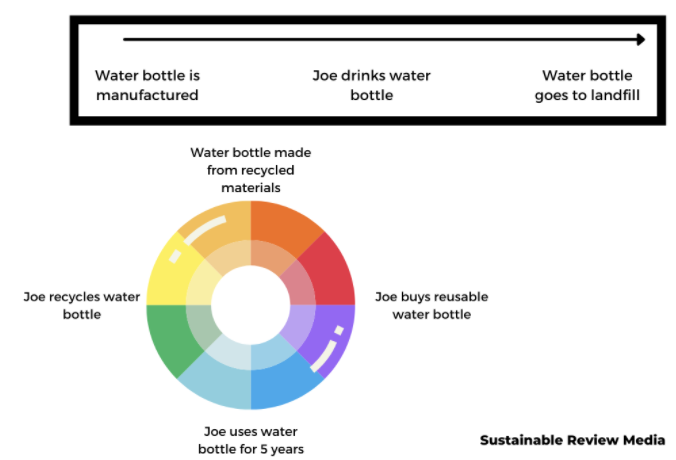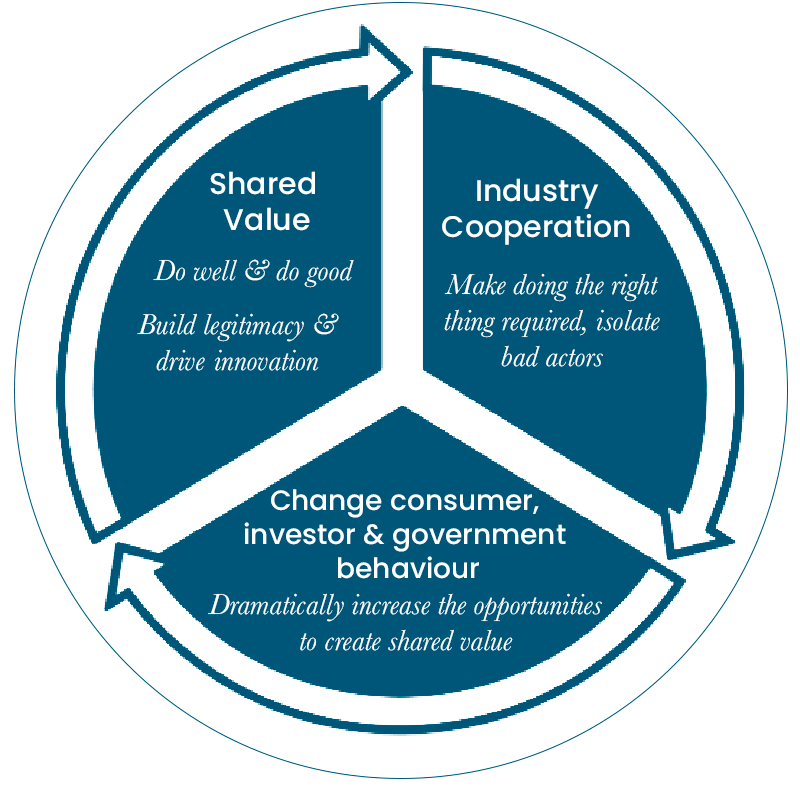AASAN IMPACT
Glossary
AASAN IMPACT
Glossary
Environmental, Social And Governance (ESG)
A business strategy that encompasses an environmental cause, social cause, and self-governing body in leadership that holds the company accountable.
Biocontributive (Or Regenerative)
Consumers increasingly want to buy into brands with the smallest possible environmental footprint, but brands are increasingly saying that they can do better — by restoring the resources they use. Biocontributive, regenerative or carbon-positive brands are now in demand, and go one step further than companies talking about carbon offsetting and carbon neutrality. Agriculture and tourism were the two sectors that talked most about regeneration in 2020.
Bioplastics
Materials made from biomass (plant or animal materials that are used as a renewable energy source, like wood or waste from yards) rather than petroleum, which is what makes traditional plastic. There are two types of bioplastics: polylactic acid (PLA), typically made from the sugars in cornstarch, sugarcane, or cassava, and polyhydroxyalkanoates (PHAs), made from microorganisms that transform organic materials into plastic. Bioplastics are often, but not always, biodegradable. And even when they are biodegradable, they may not break down if they end up, as much waste does, in the ocean. A PLA straw, for example, will not degrade in that environment.
Blue Economy
Economic activities that create sustainable wealth from the world’s oceans and coasts.
Build Back Better
First used at a United Nations conference on future disaster avoidance in 2015. Politicians and business leaders use this phrase alongside “green recovery” to communicate to citizens and consumers a brighter, more sustainable future.
Carbon Footprint
The total amount of greenhouse gases released into the atmosphere as a result of the activities of the business. It can be reduced by improving the sustainability of a business.
Carbon Neutral
If something is carbon neutral, it means its carbon dioxide emissions and carbon dioxide absorption equal each other out, leading to net neutral emissions. Products, companies, and even individuals can be carbon neutral (or at least, aspire to be). Often, becoming so involves the purchase of carbon offsets.
Carbon Offsets
Purchasable reductions in greenhouse gas (GHG) emissions, often utilized to help attain carbon neutrality goals. A company might, for example, pay to plant trees in order to help compensate for its carbon footprint, or it might, as some airlines do, offer ways for consumers to pay to offset the emissions of their purchases (in this case, flights). This tactic is not a fix for climate change, but it can help as organizations and governments work to build less environmentally harmful practices.
Carbonomics
In a year of net-zero targets, carbonomics was used in conversations about the cost of decarbonisation. Popular in environmental, social and governance investing circles, it was used this year by Bloomberg for its Future of Energy show and Goldman Sachs in its The Green Engine of Economic Recovery report. Read more →
Circular Economy
In a traditional linear economy, the process goes ‘make, use, dispose’. In a circular economy, we try to minimize ‘make’ and ‘dispose’, and maximize ‘use’. Circular economies use products or services to their fullest. When the product lifecycle is complete, you must repurpose that material back into the production phase.
Circular V’s Linear Economy
Climate Change A long-term shift in weather patterns, regionally and globally. Typically, it’s used to refer to the human-made rise in global temperatures that’s occurred between the middle of the 20th century and the present day.
Climate Emergency
A situation in which urgent action is required to avoid catastrophic and irreversible damage to the environment that threatens all life on Earth, including that of humans. Many governments worldwide have declared the present moment to be a climate emergency.
Collective Impact
Cross-sector coordination to bring about large-scale change.
Conscious Capitalism
A free-market economy that seeks to mutually benefit both people and environment.
Conscious Consumerism
Consumers voting with their wallet – purchasing products and services that are produced responsibly.
Doughnut Economics
An economic theory, represented by a doughnut-shaped diagram, for operating within the boundaries of social and environmental sustainability.
Global Reporting Initiative (GRI)
An independent international organization that has pioneered sustainability reporting since 1997. GRI helps businesses and governments worldwide understand and communicate their impact on critical sustainability issues such as climate change, human rights, governance and social well-being.
Greenwashing
A marketing tactic that inaccurately portrays a “green” or “eco-friendly” product or service to increase sales.
Integrated Reporting
An approach to corporate reporting that integrates financial information and non-financial (e.g. sustainability) information into a single document to show how a company is performing.
Net Zero
United Nations secretary-general António Guterres said in a speech that there was “no excuse” for humanity to fail to limit global warming to 1.5ºC, which means the world must achieve net-zero emissions before 2050, and cut emissions by half by 2030. That speech, and the UN’s Race to Zero campaign, has prompted more than 100 countries and 1,500 companies worth US$11.4 trillion to make net-zero promises.
Sustainability
Sustainability creates and maintains the conditions under which humans and nature can exist in productive harmony, without jeopardizing the ability of future generations to also meet their needs. Built upon the three pillars of social, economic and environmental stewardship.
Sustainability Risk Management (SRM)
A business strategy that aligns profit goals with a company’s environmental policies. The goal of SRM is to make this alignment efficient enough to sustain and grow a business while preserving the environment. One of the chief drivers for SRM adoption is increasing demand for compliance with global and national regulations.
Sustainability Transformation
A fundamental shift in the way that an organization conducts business, resulting in economic, social and environmental impact. Shifting from a profit-driven mindset to a purpose and profit driven mindset.
Sustainable Business
A business that is economically viable, socially responsible and environmentally conscious. At the intersection of doing well (making money) and doing good (solving for the world’s social and environmental problems) is shared value.
Sustainable Development Goals (SDGs)
A collection of 17 interlinked global goals designed to end poverty, protect the planet and ensure that all people enjoy peace and prosperity by 2030. They were adopted by the United Nations in 2015.
Triple Bottom Line
A framework or theory that recommends that companies commit to focus on social and environmental concerns just as they do on profits. Businesses of all sizes incorporate a triple bottom line strategy – a business strategy that prioritizes people, planet and profit equally.
Upcycling
The use of waste materials to make something different from the would-be wasted materials. An example of this would be the use of plastic bottles in shoes and clothing, which is currently being undertaken by companies like Everlane, Allbirds, Patagonia, Buffy, and others. This prevents waste while also reducing the need for virgin materials to make new products.
Wheel Of Change
Process of transformation towards sustainability. The interaction of shared value, industry cooperation, and change in consumer, investor and regulatory behaviour. Supporting the development of inclusive institutions is the final piece in the wheel of change. Successful sustainability transformation is rooted in clarity of purpose.
Zero Waste
The conservation of all resources by means of responsible production, consumption, reuse, and recovery of products, packaging, and materials without burning and with no discharges to land, water, or air that threaten the environment or human health.
Circular economy
In a traditional linear economy, the process goes ‘make, use, dispose’. In a circular economy, we try to minimize ‘make’ and ‘dispose’, and maximize ‘use’. Circular economies use products or services to their fullest. When the product lifecycle is complete, you must repurpose that material back into the production phase.
Circular v's Linear economy

Sustainability
Sustainability creates and maintains the conditions under which humans and nature can exist in productive harmony, without jeopardizing the ability of future generations to also meet their needs. Built upon the three pillars of social, economic and environmental stewardship.
Wheel of Change
Process of transformation towards sustainability. The interaction of shared value, industry cooperation, and change in consumer, investor and regulatory behaviour. Supporting the development of inclusive institutions is the final piece in the wheel of change. Successful sustainability transformation is rooted in clarity of purpose.

Let’s work together.
We start every project with a simple conversation, getting to know your values and your business needs. Then we create a customized work plan to bring your sustainability commitment and vision to reality.
Let’s work together.
We start every project with a simple conversation, getting to know your values and your business needs. Then we create a customized work plan to bring your sustainability commitment and vision to reality.

